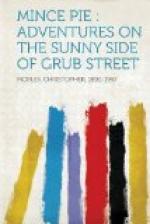Just why this remote atheneum was sconce for Mr. Holliday’s candle I do not hazard. It seems I have heard him say that his cousin, Professor Wilbur Cortez Abbott (of Yale) was then teaching at the Kansas college, and this was the reason. It doesn’t matter now; fifty years hence it may be of considerable importance.
However, we must press on a little faster. From Kansas he returned to New York and became a salesman in the book store of Charles Scribner’s Sons, then on Fifth avenue below Twenty-third street. Here he was employed for about five years. From this experience may he traced three of the most delightful of the “Walking-Stick Papers.” It was while at Scribner’s that he met Joyce Kilmer, who also served as a Scribner book-clerk for two weeks in 1909. This friendship meant more to Bob Holliday than any other. The two men were united by intimate adhesions of temperament and worldly situation. Those who know what friendship means among men who have stood on the bottom rung together will ask no further comment. Kilmer was Holliday’s best man in 1913; Holliday stood godfather to Kilmer’s daughter Rose. On Aug. 22, 1918, Mrs. Kilmer appointed Mr. Holliday her husband’s literary executor. His memoir of Joyce Kilmer is a fitting token of the manly affection that sweetens life and enriches him who even sees it from a distance.
Just when Holliday’s connection with the Scribner store ceased I do not know. My guess is, about 1911. He did some work for the New York Public Library (tucking away in his files the material for the essay “Human Municipal Documents”) and also dabbled in eleemosynary science for the Russell Sage Foundation; though the details of the latter enterprise I cannot even conjecture. Somehow or other he fell into the most richly amusing post that a belletristic journalist ever adorned, as general factotum of The Fishing Gazette, a trade journal. This is laid bare for the world in “The Fish Reporter.”
About 1911 he began to contribute humorous sketches to the Saturday Magazine of the New York Evening Post. In 1912-13 he was writing signed reviews for the New York Times Review of Books. 1913-14 he was assistant literary editor of the New York Tribune. His meditations on the reviewing job are embalmed in “That Reviewer Cuss.” In 1914 the wear and tear of continual hard work on Grub Street rather got the better of him: he packed a bag and spent the summer in England. Four charming essays record his adventures there, where we may leave him for the moment while we warm up to another aspect of the problem. Let us just set down our second memorandum:




